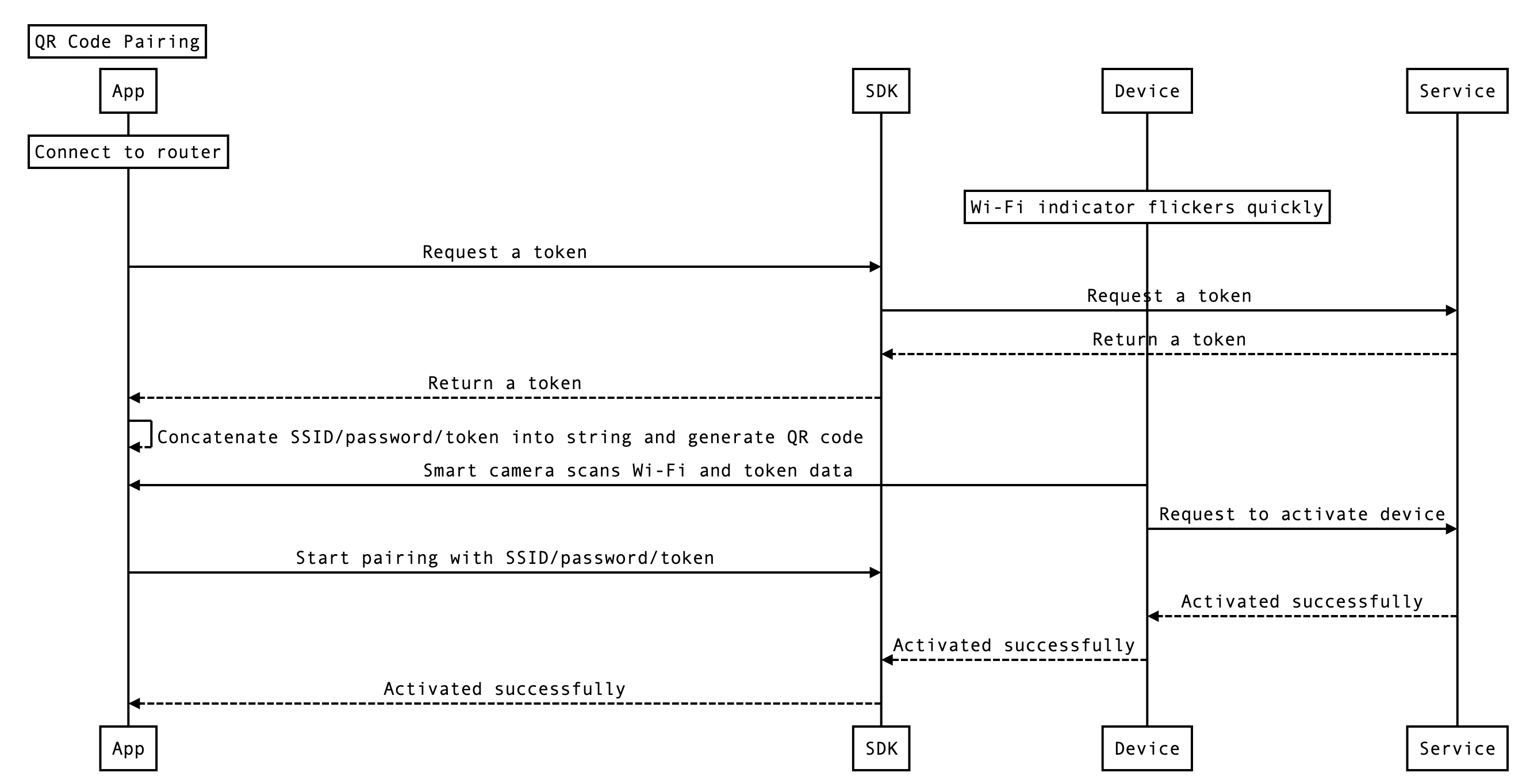Smart Camera Pairing in QR Code Mode
Last Updated on : 2023-05-22 06:38:25download
A smart camera can scan a QR code on the app to get the pairing data. Users can pair the smart camera in this way.
Pairing process

Initialize pairing parameters
API description
TuyaCameraActivatorBuilder builder = new TuyaCameraActivatorBuilder()
.setContext(context)
.setSsid(ssid)
.setPassword(password)
.setToken(token)
.setTimeOut(timeout)
.setListener(new ITuyaSmartCameraActivatorListener() {
@Override
public void onQRCodeSuccess(String qrcodeUrl) {
// The URL used to generate a QR code.
}
@Override
public void onError(String errorCode, String errorMsg) {
// Failed to pair the device.
}
@Override
public void onActiveSuccess(DeviceBean devResp) {
// The device is paired.
}
}));
Parameters
| Parameter | Description |
|---|---|
| token | The pairing token. |
| context | The context to be set in activity. |
| ssid | The name of the Wi-Fi network to which a paired device is connected. |
| password | The password of the Wi-Fi network to which a paired device is connected. |
| timeout | The timeout value of a pairing task. Default value: 100. Unit: seconds. |
Get a token
Before the smart camera pairing process, the SDK must get a pairing token from the cloud in the networked state. The token is valid for 10 minutes and expires immediately after the device is paired. A new token must be generated if the device needs to be paired again.
API description
TuyaHomeSdk.getActivatorInstance().getActivatorToken(homeId,
new ITuyaActivatorGetToken() {
@Override
public void onSuccess(String token) {
}
@Override
public void onFailure(String s, String s1) {
}
});
Parameters
| Parameter | Description |
|---|---|
| homeId | The home ID. For more information, see Home Management. |
Call the pairing method
-
Pairing implementation class.
ITuyaCameraDevActivator mTuyaActivator = TuyaHomeSdk.getActivatorInstance().newCameraDevActivator(builder); -
Returns the URL of the QR code.
mTuyaActivator.createQRCode(); // The result is returned by the callback of `onQRCodeSuccess`. -
Generates a QR code by using the URL.
In the following example, this dependency is required:
zxing(implementation 'com.google.zxing:core:3.2.1').public static Bitmap createQRCode(String url, int widthAndHeight) throws WriterException { Hashtable hints = new Hashtable(); hints.put(EncodeHintType.CHARACTER_SET, "utf-8"); hints.put(EncodeHintType.MARGIN,0); BitMatrix matrix = new MultiFormatWriter().encode(url, BarcodeFormat.QR_CODE, widthAndHeight, widthAndHeight, hints); int width = matrix.getWidth(); int height = matrix.getHeight(); int[] pixels = new int[width * height]; for (int y = 0; y < height; y++) { for (int x = 0; x < width; x++) { if (matrix.get(x, y)) { pixels[y * width + x] = BLACK; } } } Bitmap bitmap = Bitmap.createBitmap(width, height, Bitmap.Config.ARGB_8888); bitmap.setPixels(pixels, 0, width, 0, 0, width, height); return bitmap; } -
Starts pairing.
mTuyaActivator.start(); -
Stops pairing.
mTuyaActivator.stop(); -
Destroys data.
mTuyaActivator.onDestory();
Is this page helpful?
YesFeedbackIs this page helpful?
YesFeedback





